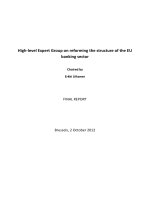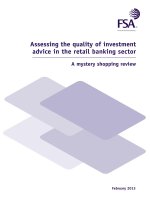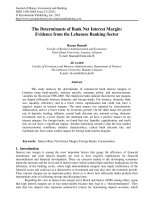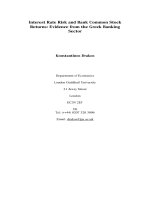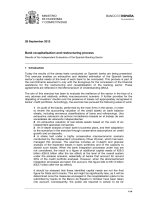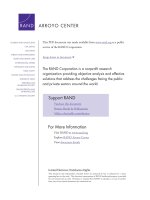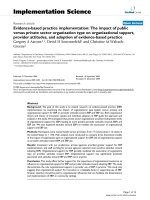The impact of bonding, trust and satisfaction on customer commitment an empirical study of the vietnamese banking sector
Bạn đang xem bản rút gọn của tài liệu. Xem và tải ngay bản đầy đủ của tài liệu tại đây (1.15 MB, 81 trang )
MINISTRY OF EDUCATION AND TRANNING
UNIVERSITY OF ECONOMICS HO CHI MINH CITY
------------
ĐOÀN THỊ THÙY TRANG
THE IMPACT OF BONDING, TRUST AND
SATISFACTION ON CUSTOMER
COMMITMENT: AN EMPIRICAL STUDY
OF THE VIETNAMESE BANKING
SECTOR
MASTER THESIS
HO CHI MINH CITY – 2012
MINISTRY OF EDUCATION AND TRANNING
UNIVERSITY OF ECONOMICS HO CHI MINH CITY
------------
ĐOÀN THỊ THÙY TRANG
THE IMPACT OF BONDING, TRUST AND
SATISFACTION ON CUSTOMER
COMMITMENT: AN EMPIRICAL STUDY
OF THE VIETNAMESE BANKING
SECTOR
MAJOR: BUSINESS ADMINITRATION
MAJOR CODE: 60340102
MASTER THESIS
SUPERVISOR: Assoc. Prof. Dr. NGUYỄN ĐÌNH THỌ
HO CHI MINH CITY – 2012
I
ACKNOWLEDGEMENT
First and foremost I would like to thank my supervisor, Assoc. Prof. Dr Nguyễn
Đình Thọ for his guidance and support. His feedback is valuable for my thesis. The
time of coordinating with him is the valuable opportunities that helps widen my
knowledge.
Second, I would like to thank all of my lecturers at Business Admistration Faculty,
University of Economics Ho Chi Minh City who supported my knowledge during
the MBA course.
Third, I also thank my friends who helped me collect data for this thesis. Moreover,
I would like to express my appreciation to Mr. Cao Quoc Viet for his guidance in
analyzing data with SPSS.
Finally, my greatest thank would go to my family who always encourage me to
finish this course.
Đoàn Thị Thùy Trang
Ho Chi Minh, 20 October 2012
II
COMMITMENT
I would like to declare that this study, “The Impact of Bonding, Trust and
Satisfaction on Customer Commitment: an Empirical Study of the Vietnamese
Banking Sector”, was implemented based on my independent and serious studies as
well as scientific researches. The data was collected in reality and it has clear
origins.
Đoàn Thị Thùy Trang
Ho Chi Minh, 20 October 2012
III
TABLE OF CONTENT
ACKNOWLEDGEMENT .......................................................................................... I
COMMITMENT ........................................................................................................ II
TABLE OF CONTENT ............................................................................................III
LIST OF TABLE ..................................................................................................... VI
LIST OF FIGURE ................................................................................................... VII
ABSTRACT ................................................................................................................1
CHAPTER 1: INTRODUCTION ...............................................................................2
1.1. Research background ...........................................................................................2
1.2. Statement of problem ...........................................................................................3
1.3. Research questions ...............................................................................................5
1.4. Research objectives ..............................................................................................5
1.5. Research methodology .........................................................................................6
1.6. The structure of the research ................................................................................6
CHAPTER 2: LITERATURE REVIEW ....................................................................8
2.1. The Nature and Role of Commitment ..................................................................8
2.2. Bonding definition and impact of bonding on customer commitment ..............10
2.3. Trust definition and impact of trust on customer commitment ..........................11
2.4. Satisfaction definition and impact of satisfaction on customer commitment ....14
2.5. Conceptual model...............................................................................................16
2.6. Summary ............................................................................................................16
CHAPTER 3: RESEARCH METHODOLOGY ......................................................17
3.1. Research design ..................................................................................................17
3.2. Questionnaire development ................................................................................18
3.2.1. Independent variables ..................................................................................18
3.2.2. Dependent variable: commitment ...............................................................19
3.3. Questionnaire translation ...................................................................................20
IV
3.4. Research strategy ...............................................................................................21
3.4.1. Qualitative pilot study .................................................................................21
3.4.2. Quantitative pilot study ...............................................................................21
3.5. Target population ...............................................................................................22
3.6. Sample size .........................................................................................................22
3.7. Selecting the sample and collecting data ...........................................................22
3.8. Methods of data analysis ....................................................................................24
3.8.1. Data cleaning ...............................................................................................24
3.8.2. Reliability assessment of measurement scales (Cronbach’s alpha) ............24
3.8.3. Validity assessment of measurement scales ................................................25
3.8.4. Multiple Linear Regression (MLR) .............................................................25
3.9. Research process ................................................................................................25
3.10. Summary ..........................................................................................................26
CHAPTER 4: DATA ANALYSIS AND FINDINGS ..............................................27
4.1. Descriptions of sample .......................................................................................27
4.2. Reliability of the measurements .........................................................................29
4.3. Exploratory factor analysis (EFA) .....................................................................31
4.3.1. EFA implementation for independent variables ..........................................31
4.3.2. EFA implementation for dependent variable ..............................................34
4.4. Testing the research model and the hypothesis ..................................................34
4.4.1. Testing the correlations of the constructs ....................................................34
4.4.2. Testing Assumptions of Linear Regression.................................................35
4.4.3. Multiple Linear Regression Analysis ..........................................................36
4.5. Summary ............................................................................................................39
CHAPTER 5: CONCLUSION ..................................................................................40
5.1. Discussion of findings ........................................................................................40
5.1.1. Bonding .......................................................................................................41
5.1.2. Trust .............................................................................................................41
5.1.3. Satisfaction ..................................................................................................41
V
5.2. Practical implications .........................................................................................42
5.3. Contribution of the current study .......................................................................45
5.4. Limitation and future research ...........................................................................45
REFERENCES ..........................................................................................................47
APPENDIX I .............................................................................................................53
APPENDIX 2 ............................................................................................................56
APPENDIX 3 ............................................................................................................60
APPENDIX 4 ............................................................................................................69
VI
LIST OF TABLE
Table 3.1. Survey items ……………………………………………….………....19
Table 4.1. Respondents’ profiles…………………………………………………28
Table 4.2. Reliability of the measurements and related decision ………..……. ..30
Table 4.3. EFA results of independent variables ……………………..………. ...33
Table 4.4. EFA results of dependent variables ………………………………... ..34
Table 4.5. Correlations ………………………………………………………......35
Table 4.6. MRL results using Enter technique ….…………………………….....36
Table 4.7. ANOVA.. ……………………………………………………….….. ..36
Table 4.8. Coefficients…………………………………………………………....37
Table 4.9. Results of testing hypothesis ………………………..……………….. 37
VII
LIST OF FIGURE
Figure 2.1. Conceptual model …………………….………………...………. .16
Figure 3.1. Research process……………………………………….………… 25
Figure 4.1. Model with Beta values…………………………..……….……… 38
1
ABSTRACT
To survive in a high competitive environment, banks must have marketing strategy
to build a long-term relationship with their customers by improving customer
commitment.
This thesis aimed to investigate the impact of bonding, trust and satisfaction on
customer commitment in the Vietnamese banking sector by empirical evidence.
The thesis consisted of five chapters including introduction, literature review,
research methodology, data analysis and findings, conclusion. After the introduction
chapter, the study indicated related literature on bonding, trust, satisfaction and the
affect of these components on customer commitment. Then, the research
methodology introduced the procedure of the research. The data analysis and
findings used SPSS version 16 to analyze collected data. Finally, the main
conclusion and implication of the study stated in the conclusion chapter.
Our findings showed that bonding, trust and satisfaction had positive effect on
customer commitment. Among these factors, satisfaction got highest weight
influence on customer commitment. Trust was more important in affecting
commitment compared with bonding.
2
CHAPTER 1
INTRODUCTION
1.1. Research background
The target of marketing is not only finding new customers but also building longterm relationship with existing ones. In traditional marketing, marketers pay more
attention to increase number of new customers. Kotler (2000) shows that companies
concentrate on attracting new customers rather than retaining existing ones.
Traditional marketing uses marketing mix to increase sales; and marketers are
familiar with the concept of 4Ps to attract new customers. Nowadays, when the
economic environment is changing rapidly and becoming saturated, finding a good
new customer becomes more and more difficult. Therefore, the companies must
change their mind to survive. They must pay more attention on finding the best way
to develop the long-term relationship with their current customers besides finding
new ones. The word “loyalty” has been started to appear frequently and it has
become a highly desirable marketing goal (Mele, 2001). To survive in mature
market, the companies must rely on sustaining long-term relationships with
stakeholders (De madariaga and Valor, 2007). Points of view in marketing are
changed to fulfill the requirement of the economic reality.
Relationship marketing is considered a good way to retain customers. Marketers
find that it is hard to satisfy their customers’ need which multiplies more and more.
Customers are smarter, more reluctant; and they also have more choices. They can
easily switch for many reasons such as dissatisfaction with existing suppliers, lower
price, better services from competitors or any other personal reasons. Therefore,
marketing scholars emphasize the important role of relationship marketing. A lot of
empirical studies have been carried out to prove the importance of relationship
marketing. Eisingerich and Bell (2006) find that financial institutions should pay
attention to the relative of individual relationship in building marketing strategy to
3
foster customer loyalty. Empirical finding of Chaston et al.’s (2003) suggests that
adoption of a relationship versus a transactional marketing orientation affect market
performance of small accountancy practices. According to the finding of Sheth
(2000), relationship marketing is “the on going process of engaging cooperative and
collaborative activities and programs with immediate and end-used customers to
create or enhance mutual economic value at reduced cost”. Theory and empirical
study have already proved the role of relationship marketing in building long-term
relationship with customers.
Commitment is considered one of most important components in relationship
marketing. Pritchard et al. (1999) find that commitment impacts strongly on
customer loyalty. Commitment is an essential component of the long-term loyalty
(Morgan & Hunt, 1994). It helps the customers less affect the competitors’ action
(Bettencourt, 1997). Morgan and Hunt (1994) prove that commitment has high
influence in loyalty and vice versa. Some relationship marketing models use
commitment as an independent component (Kumar et al., 1995). In conclusion,
commitment can help the companies build long-term relationship with customers.
In Vietnamese banking industry, customer commitment is the target of any banks in
building stable relationship with customers. Since the Communist Party of Vietnam
decided to reform the economy in 1986, the number of banks has increased quickly
in both domestic and foreign ownership. The competitive environment increases
rapidly in domestic as well as in foreign banks; therefore, current customers are the
foundation for banks to improve their business. Customer commitment can help the
bank get sustainable development.
1.2. Statement of problem
Since 1986, the Vietnamese economy has been transformed from a centrallyplanned economy into a market-oriented economy. With the permission of private
sector, a lot of private banks were born. According to the statistic from the State
Bank of Vietnam, on 15 June 2012, there are 99 banks in Vietnam including
4
braches of foreign banks and 21 representative offices of foreign banks. The
competition has increased strongly because banks now not only compete with
domestic banks but also with foreign ones. Banks are facing with the risk of
reducing market share. Banking products are easily to imitate; therefore, banks must
differentiate themselves from competitors by increasing service levels. They must
create competitive advantages. Once a bank builds a long-term relationship with
customer, the ability of shifting to another bank of its customers will be reduced.
Banks understand that keeping long-term relationship with customers is a wise
strategy. Finding new stable customers is costly and timely. Gilaninia et al. (2011)
shows that the cost of finding and serving one new customer is five to six times
more than the cost of serving one loyal customer. Doing business with continuing
customers saves money on a variety of recruitment costs such as:
-
Costs of advertising to entice new customers;
-
Costs of personal selling pitch to new prospects;
-
Costs of setting up new accounts;
-
Costs of explaining business procedures to new clients; and
-
Costs of inefficient dealings during the customer’s learning process
5% increase in customer retention leads to 60% company’s profit growth by the
fifth year (Reichheld, 1996). But continuing customers profit the company more
than by saving on costs. They progress to buying more of their total requirements
from one supplier, and buy a more comprehensive product line from the supplier.
The longer a business firm can keep a customer, the greater the life-time revenue
from that customer. Furthermore, while revenues increase from the same customer,
the costs of serving him/her decline. Customers are one of the most valuable assets,
therefore, banks must not only reserve but also continuously expand their
relationship with customers.
5
Retaining customers is the current problem for bank marketers in Vietnam. High
competitive forces banks to find ways to satisfy customers. Managers must
implement many strategies to get customer commitment because it is the foundation
for sustaining development. However, it is hard to find empirical studies on
commitment in banking sector in Vietnam. There are not many surveys in this field
although it is really important and useful for banks to carry out their marketing
strategy; hence, this study aims to investigate what factors affect customer
commitment in the Vietnamese banking sector and the important of each factor on
customer commitment. According to the result of this study, banks can run their
marketing strategies to improve their business.
This study is based on the literature of relationship marketing to identify whether
bonding, trust, satisfaction have impact on customer commitment.
1.3. Research questions
This study examines the impact of bonding, trust, satisfaction on customer
commitment. Therefore, it aims to answer the questions concerned in banking
industry as follows:
Question 1: Do bonding, trust and satisfaction have an impact on customer
commitment?
Question 2: Do these components of relationship marketing orientation have the
same impact on customer commitment?
1.4. Research objectives
The objectives of the study are:
-
To examine the relationship between bonding and customer commitment.
-
To examine the relationship between trust and customer commitment.
6
-
To examine the relationship between satisfaction and customer
commitment.
-
To determine which factor influences most customer commitment.
1.5. Research methodology
First, this study is empirical based on the data collected in Ho Chi Minh city,
Vietnam which is the economic center of Vietnam. People living in Ho Chi Minh
city have more chances to access banking services than other areas in Vietnam;
therefore, they can give better answers about their experience in using banking
services.
Second, the study carries out in 02 steps: pilot study and main study. The purpose of
the pilot study is to do previous test of the measurement scales. After the pilot test,
the study collects the sample of about 300 respondents.
Third, the statistical package SPSS version 16 is used to find out the result
1.6. The structure of the research
The study is presented in 5 chapters.
Chapter 1: Introduction.
This chapter introduces research background, research problem, research question,
research objective, methodology and the organization of the research.
Chapter 2: Literature review.
This chapter specifies on the theory relevant to commitment and its components and
empirical study customer commitment.
Chapter 3: Research methodology.
This chapter describes the methodology used to conduct the research.
Chapter 4: Data analysis and findings.
7
Base on the data collected, SPSS version 16 is used to test the hypothesis and
answer the research questions.
Chapter 5: Conclusion
The conclusion is based on the result of data analysis. Limitation of the research is
also indicated.
8
CHAPTER 2
LITERATURE REVIEW
This chapter presents the related literature on commitment and the components
affect customer commitment. According to the literature and empirical study,
bonding, trust and satisfaction have positive effect on customer commitment. This
chapter also indicates conceptual model and research hypothesis.
2.1. The Nature and Role of Commitment
In the review of the commitment literature, commitment has various definitions.
Commitment is considered as critical in the literatures of organizational and buyer
behavior. Psychological theories consider commitment as the series of acts and
cognitions between a person and his behavior (Crosby & Tylor, 1983). Commitment
is a psychological phenomenon. Allen & Meyer (1990) consider commitment as
“psychological state that reflects employees’ relationship to the organization”.
Moorman et al. (1992) define commitment as “an enduring desire to maintain a
valued relationship”. According to Hocutt (1998), commitment is “an intention to
continue a course of action or activity or the desire to maintain a relationship”.
Commitment is an affective attachment to an organization values and purposes, or a
relative intensity of the identification and the involvement in a particular
organization (Buchanan, 1974). In the marketing context, commitment appears from
the confrontation of the consumer to changes. In the marketing services,
commitment considers as a consumer’s will to continue in a relationship with an
operator (Morgan & Hunt, 1994). It is possible to differentiate the loyal from the
inert consumers.
In the services relationship marketing area, mutual commitment is the foundation of
relationship. Commitment plays an important role on successful relationship,
9
especially in long-term (Anderson and Narus, 1998). Scanzoni (1979) states that
commitment is an essential component of relationship marketing models. Empirical
studies of Wetzels et al. (1998) and Farrelly & Quester (2003) prove that partners
can get significant benefits through mutual commitment in relationship. Morgan and
Hunt (1994) define commitment as a state of believing that the relationship with
exchange partner is important, hence it leads to great effort to maintain the
relationship. Commitment is the will of customer trying to maintain a relationship
with service providers. Commitment is “an implicit or explicit pledge of relational
continuity between exchange partners” (Dwyer et al., 1987). It is a “pledge of
continuity” (Dwyer et al, 1987). It is the most advance phase of interdependence
between the service provider and the customer. Commitment can prevent the
customer seeking another company providing a similar advantage. The durability of
the relationship can get by the habit or the constraint of the market. Morgan & Hunt
(1994) states that customer’s commitment corresponds to a strong desire to preserve
the relationship with the seller with agreeing to provide the efforts that might be
essential.
Commitment is considered as a multi-dimensional construct including three
dimensions: continuance commitment, affective commitment and normative
commitment (Meyer and Allen, 1997).
Continuance commitment is the desire to maintain a relationship due to high
switching costs and scare alternatives (Meyer and Allen, 1997). Customer with
strong continuance commitment attach to the organization based on financial and
tangible perceived value of the relationship.
Affective commitment is an emotional bonding that customer feels belonging and
involving with service provider (Fullerton, 2005). Affective commitment relates to
the desire to maintain a relationship valuable to customer in feeling (Morgan &
Hunt, 1994). Customer with strong effective commitment attaches to the
organization based on their emotion.
10
Normative commitment is a perceived obligation to remain in the organization
(Meyer et.al. 2002). Customer believes staying with an organization as a
responsibility and a right thing to do.
To sum up, continuance commitment refers to the relationship that customer need to,
affective commitment refers to the relationship that customer want to and normative
commitment relates to the feeling of ought to do so (Allen and Meyer, 1990).
2.2. Bonding definition and impact of bonding on customer commitment
Bonding is an emotional relationship between two partners (customer and supplier
or buyer and seller) acting in a unified manner toward a desired goal (Callaghan et
al., 1995; Sin et al., 2005b). Human bonding is the process of development of a
close, interpersonal relationship. Bonding derives from the relationship of family
members or friends or among groups when people spend time together. Bonding is
a mutual and interactive process. Bonding is the results of interaction between
people. Any two people who spend time together, share activities may form a bond.
Bonding help people have close relationship with others. When people have the
same goal, the same value, the same character or other things and they share with
their partner, the bond will arise.
Bonding has two main dimensions: social bonds and structural bonds (Wilson,
1995).
In psychology, according to Hirschi (1969), social bonding includes attachment to
families, commitment to social norms and institutions (school, employment),
involvement in activities, and the belief that these things are important. Family,
friends, and other members of our social networks affect our lives in many ways.
People need strong positive social ties to represent society in the best way possible.
Social bond has four dimensions (Hirschi, 1969) including attachment, commitment,
involvement and belief. In marketing theory, Wilson (1995) defined social bonding
is “the degree of mutual personal friendship and liking shared by the buyer and
seller”. Social bond is used to investigate friendships, sexual relationships, family
11
and group interactions. Personal social bond develops subjective social interaction.
Individual may develop strong personal relationships that tend to hold a relationship
together. Buyers and sellers who have strong personal relationship are more
committed to maintain a relationship than less socially bond partners.
The concept of structural bond is the vector of forces that create impediments to the
termination of the relationship. Although individual constructs tend to either
strengthen or weaken a relationship, their interaction may be greater than the sum of
their parts in creating a force to hold a relationship together. Structural bond
develop over time as the level of the investments, adaptations and share technology
grows until a point is reached when it may be very difficult to determine a
relationship. Firm with high level of structural bond is found to have a higher level
of commitment to the continuance of the relationship than firms with lower levels of
structural bonding. In conclusion, structural bond appears when partners adapt
themselves to the others in some legal, economic or technical, knowledge elements
(Wilson and Mummalaneni, 1986; Wilson, 1995). For example, the relationship
between the manager and his staff is structural bond.
Commitment in a relationship is a result of social bond (Mummalaneni and Wilson,
1991). Building strong bonds will decrease dispute between buyer and seller
(Palmatier et al., 2007). Stronger personal bonds effect stronger commitment
between buyers and sellers (Willson and Mummalaneni, 1986).
H1: Bonding has a positive influence on customer commitment.
2.3. Trust definition and impact of trust on customer commitment
Trust has been studies widely in the social exchange literature. In the marketing
context, the study of trust is mainly based on buyer-seller models. Customercompany relationship requires trust. Trust is a personal trait and a general
disposition to believe others. Morgan and Hunt (1994) define trust as “when one
party has confidence in an exchange partner’s reliability and integrity”. It is an
important component of transition from transactional to relational conceptions. It
12
allows preserving the long-term relations, resisting the different competitors and
reducing uncertainty in terms of exchange. Trust is considered a part of the
partner’s integrity. It relates the reliability of the partner, his expertise and his past
behavior. Callaghan et al. (1995) define trust is a state of believing in someone or
something about the truth, goodness, character, power and ability. When a person
relies on received information about unsure states of the environment and the
consequences in a situation of risk, trust appears. Dupuy et al., 1989 state that trust
is a reciprocal expectations system that helps people feel safety, predict the future
behavior of the partner, rely on the partner and faithful with him. The more do
partners trust each other, the less do they compare profits and costs (Wetzels et al.,
1998).
Trust has two dimensions: cognitive and affective (Garbarino & Johnson, 1999).
Cognitive refers to partner’s integrity. When a customer contact with the service
provider, he appreciates the performance of the service provider and ability of
making him satisfied. A credible seller allows the consumer to have, on the one
hand, a discriminating advantage and on the other, a predictable and stable answer.
Affective refers to the relational aspect which is based on the honesty. This
dimension is important for the success of the relationship between buyer and service
provider (Morgan & Hunt, 1994). The customer evaluates the motivations of the
service provider and seeks to how whether the latter remains aware about his goodwilling and safety, and if he is benevolent.
Trust has been treated in one of two distinct ways in the literature. First, trust has
been conceptualized as a feature or an aspect of relationship quality. Many
researchers describe trust as a feature of relationship quality, along with satisfaction
and opportunism; or as a feature of relationships, in addition to power,
communications, and goal compatibility.
Second, consistent with the view adopted in our research, trust has been
conceptualized as a determinant of relationship quality. Trust is a determinant of the
13
amount of cooperation and the functionality of conflict between parties. It is also
considered as trustworthiness, in addition to believability and honesty, as part of
credibility, which determines perceptions of service quality. Finally, it is a
determinant of communications between parties.
Trust increases the partners’ willingness in sharing information and finding new
mutual benefits (Hart and Saunders, 1997). When customers have positive
experiences on an organization, they will trust it and hence continue the relationship
with it (Vesel and Zabkar, 2010). Hocutt (1998) indicates that keeping promise and
having customer’s interest at heart can increase level of trust. Trust is the result of
experience accumulate for long time and it is difficult to get back when it is hurted
(Ossi and Joseph, 2007)
Commitment and trust play an important role on building long-term relationship
with customer. They can produce outcomes that promote efficiency, productivity
and effectiveness. Morgan and Hunt (1994) state that “they encourage marketer to
(1) work at preserving relationship investments by cooperating with exchange
partners, (2) resist attractive short-term alternatives in favor of the expected longterm benefits of staying with existing partners, and (3) view potentially high risk
actions as being prudent because of the belief that their partner will not act
opportunistically”.
The effect of trust on commitment has been proved in the literature (Chenet et al.,
2010). Trust is considered as behavioral antecedent of commitment (Palmatier et al.,
2006). If the customer thinks that the supplier is not benevolent, honest or
competent enough, he cannot rely on the supplier and will not commitment with the
supplier (Morgan & Hunt, 1994). Relationships characterized by trust are so highly
value that parties will desire to commit themselves to such relationships. Because
commitment entails vulnerability, parties will seek only trustworthy partners. Trust
leads to a high level of commitment (Morgan and Hunt, 1994; De Ruyter et al.,
2001). Besides, it helps the relationship more stable and less risky hence it increases
14
commitment (Ganesan, 1994). Many empirical prove that trust is the first stage lead
to commitment (Siguaw et al., 1998; Garbarino and Johson, 1999; Chumpitaz and
Paparoidamis, 2007; Cater and Zabkar, 2009, Irene et al.,2011). People are unlikely
to be committed to something they do not value. Because trust increases the extent
to which partners engage in risky exchanges, trust is expected to increase the
likelihood that users will become committed to relationships with researchers. To
sum up, trust is major determinant of commitment.
H2: Trust has a positive influence on customer commitment.
2.4. Satisfaction definition and impact of satisfaction on customer commitment
Customer satisfaction is one of the most important outcomes in the marketing
literature. It serves to link processes culminating purchase and consumption with
post purchase phenomena such as attitude change, repeat purchase, and brand
loyalty. Satisfaction is the customer’s overall evaluation on product or service of the
company after purchase and consumption (Andaleeb, 1996; Anderson et al., 1994;
Garbarino and Johnson, 1999). Woodruff (1997) defines customer satisfaction as an
overall positive or negative feeling based on perceived value. Level of satisfaction
belongs to how much the supplier can offer the services that meets requirement of
the customer’s expectation (Gerpott et al., 2001). Customer satisfaction is an
essential factor in establishing successful long-term relationship (Crosby et al., 1990;
Gaski and Nevin, 1985; Hennig-Thurau et al., 2002; Palmatier et al., 2006).
Cumulative satisfaction is an overall evaluation that is based on the purchase and
the consumption experience with a product or service through the time (Anderson et
al, 1994). In this case, satisfaction is feeling accumulated from consideration the
specific products of the company and some of its components such as physical
illustrations and service providers.
The feeling of satisfaction appears when the customers compare their perceptions of
actual products or services performance with their expectations. Customer
satisfaction is derived from a specific transaction represents an immediate post-
15
purchase evaluation. It can either indicate the affective reaction toward the recent
experience with the product or service. Any discrepancies between the expectations
and the performance create the disconfirmation. According to Oliver (1980), there
are three types of disconfirmation as follows:
-
If the product/service performance is higher than customer’s expectations,
they feel highly satisfied. This situation occurs positive disconfirmation.
-
If the product/service performance is lower than customer’s expectations,
they
feel
highly
dissatisfied.
This
situation
occurs
negative
disconfirmation.
-
If the product/service performance equal customer’s expectations. This
situation occurs zero disconfirmation.
Giese and Cote (2000) identified the following components of satisfaction:
-
Customer satisfaction is one kind of response (cognitive or emotional)
-
The response emphases on a particular focus ( product, consumption
experience, expectations, etc.)
-
The response occurs at a particular time (after choice, based on
accumulated experience, after consumptions, etc.)
In the competitive business market, a lot of company tries to maintain a loyal
customer base. Most of the banks set their strategies towards increasing satisfaction
and loyalty customers through the service quality. Researchers have identified
various determinants of customer satisfaction in the banking sector and relationship
between customer satisfaction and customer commitment.
Empirical study finds that satisfaction affects on customer commitment. Satisfaction
leads to commitment (Moliner et al., 2007a, b). Mittal et al. (1998) proved that
customer satisfaction has a positive effect on customer commitment. This
relationship is also proved in terms of low relationship customers by Garbarino and
Johnson (1999).
16
H3: Satisfaction has positive effect on customer commitment.
2.5. Conceptual model
Based on the literature, bonding, trust and satisfaction have positive impact on
customer commitment. The conceptual model is as figure 2.1.
The model has three independent components and the study will analyze the role of
these components on customer commitment.
Bonding
H1
H2
Trust
Customer
commitment
H3
Satisfaction
Figure 2.1. Conceptual model
2.6. Summary
Chapter 03 presents literature on commitment and the impact of bonding, trust,
satisfaction on customer commitment. Bonding, trust and satisfaction are
hypothesized having positive effect on customer commitment. Conceptual model is
built according to these relationships. The next chapter indicates research
methodology in this study.

